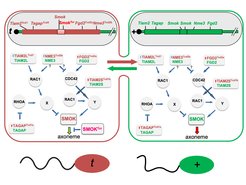Non-Mendelian inheritance in the mouse

The observation of non-Mendelian inheritance in the mouse was a fortuitous discovery published in 1936. It was observed that the recessive “allele” of the T locus, t, is transmitted at an unusually high rate from T/t males to their offspring. Five decades of genetic analysis of the t “allele” revealed that the latter consists of a chromosomal region of some 40 Mb, now called t-haplotype. It contains several distorters and a responder, which interact to achieve the high transmission ratio of the socalled t-haplotype. We have cloned the responder and four distorters and have shown that the latter act in Rho signaling cascades controlling the activity of the wild-type responder, the protein kinase SMOK, in spermatozoa swimming towards the egg cells. The distorters impair the regulation of SMOK, thereby interfering with the directional movement of sperm cells. However, the t-responder, SMOKTCR, can rescue forward progression of sperm carrying the t-haplotype conferring an advantage to spermatozoa expressing the t-responder. Thus, the latter have an advantage in reaching the egg cells faster than the spermatozoa carrying the wild-type chromosome.
We have shown that Tiam2, a Rac1-specific GEF, is acting as distorter. We have also shown that its target, the Rho small G-protein Rac1, indeed controls the progressive movement and thus the competitiveness of sperm. Our physiological data now confirm the current model that the distorters control the progressive motility of sperm. Now, we are looking for a direct link between the distorters, SMOK, and components of the axoneme.
There is no doubt that the combination of gene variants locked into the t-haplotype able to cause transmission ratio distortion is the result of a long evolutionary process involving multiple steps of mutation, selection and fine tuning. However, a crucial question has not been answered yet: is the t-responder a singular mutant gene optimized for TRD or are there more gene loci in the mammalian genome, which can act as selfish genes and enhance their transmission to the next generation?
